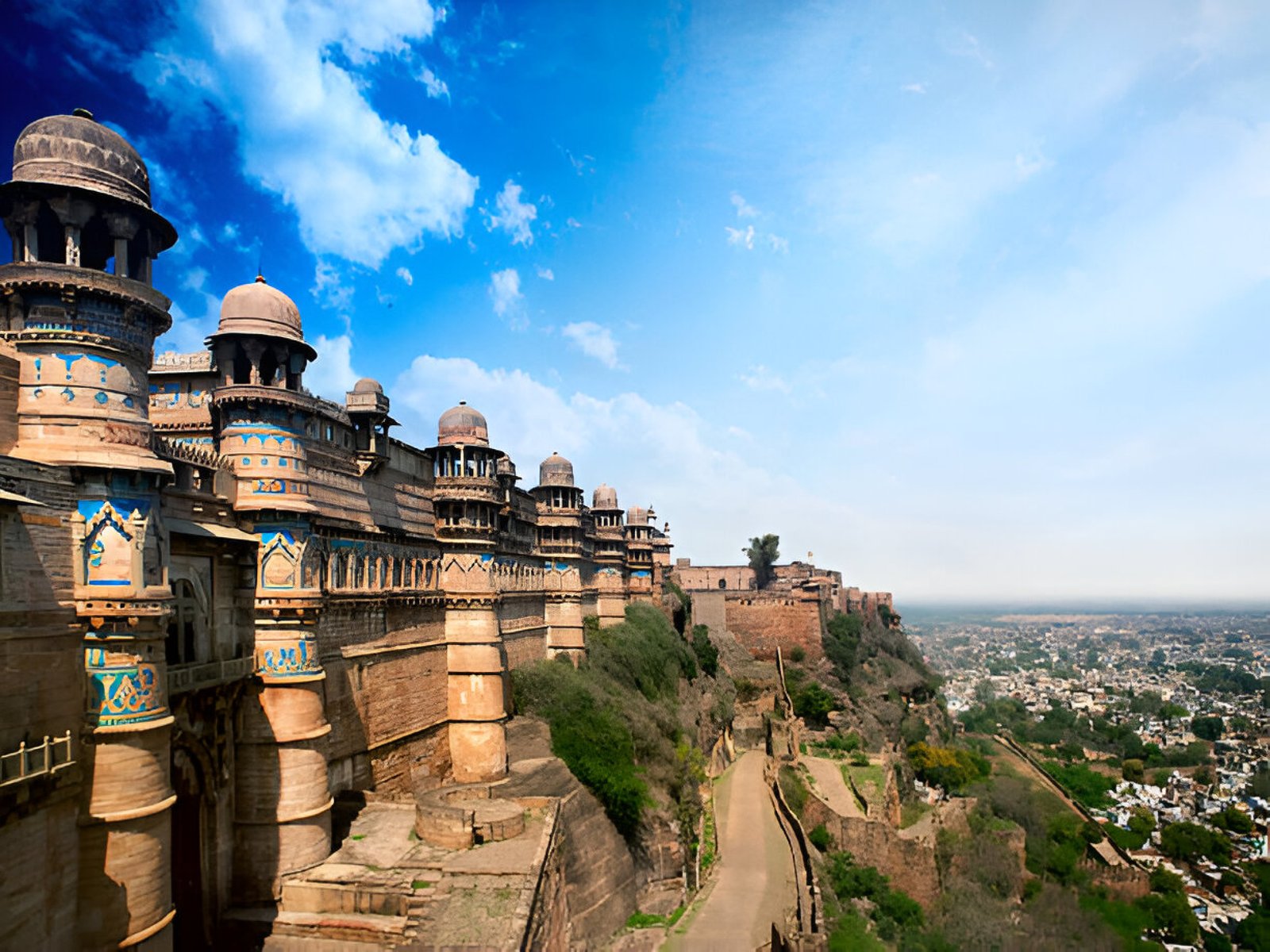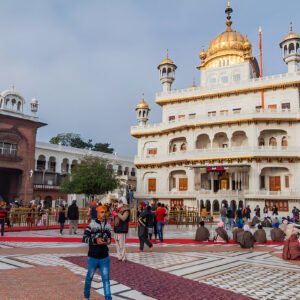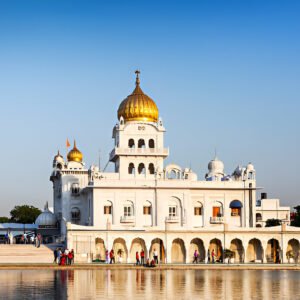Day 1: Delhi to Gwalior – The Gateway to Madhya Pradesh
- Morning: Depart from Delhi via train/flight to Gwalior (3-4 hours)
- Check-in: Heritage Hotel near Gwalior Fort
- Afternoon: Explore Gwalior Fort and Sas Bahu Temples
- Evening: Seek blessings at Sun Temple (Surya Mandir)
- Dinner: Enjoy local vegetarian cuisine in Gwalior
Sas Bahu Temples, Gwalior
These twin temples dedicated to Lord Vishnu are known for their intricate carvings and architectural brilliance from the 9th century. Despite their name, which translates to “Mother-in-law and Daughter-in-law Temples,” they hold no familial significance but rather showcase the artistic finesse of their era.
Sun Temple (Surya Mandir), Gwalior
A stunning replica of Konark’s Sun Temple, the Surya Mandir in Gwalior stands as a symbol of solar devotion. Built by the Birla family, the temple’s red sandstone structure and intricate sculptures make it a magnificent sight.
Day 2: Gwalior to Orchha – A Spiritual & Historical Marvel
- Morning: Drive to Orchha (3 hours)
- Afternoon: Visit Shri Ram Raja Temple, the only temple where Lord Rama is worshipped as a King
- Evening: Explore Chaturbhuj Temple & Lakshmi Narayan Temple
- Night: Experience Orchha’s divine evening aarti
Shri Ram Raja Temple, Orchha
The only temple where Lord Rama is worshipped as a king, this sacred site holds immense historical and religious significance. Devotees experience a unique blend of spiritual reverence and royal traditions in this temple, where guards stand as if protecting a ruling monarch.
Lakshmana Temple, Khajuraho
One of the oldest and most well-preserved temples in Khajuraho, dedicated to Lord Vishnu. The temple is a fine example of Nagara-style architecture with elaborate sculptural detailing.
Day 3: Orchha to Khajuraho – The Divine Sculpted Temples
- Morning: Drive to Khajuraho (4 hours)
Afternoon: Explore the Western Group of Temples, including: - Kandariya Mahadev Temple (dedicated to Lord Shiva)
- Lakshmana Temple
- Vishwanath Temple
- Evening: Attend the Sound & Light Show at the Khajuraho temples
Kandariya Mahadev Temple, Khajuraho
The largest and most elaborate temple in Khajuraho, this Shiva temple is adorned with intricate carvings depicting divine and human figures, symbolising devotion and life’s various aspects.
Lakshmana Temple, Khajuraho
One of the oldest and most well-preserved temples in Khajuraho, dedicated to Lord Vishnu. The temple is a fine example of Nagara-style architecture with elaborate sculptural detailing.
Vishwanath Temple, Khajuraho
Dedicated to Lord Shiva, this temple is known for its artistic grandeur, featuring depictions of celestial beings, animals, and human emotions carved on its walls.
Day 4: Khajuraho – Exploring the Lesser-Known Temples
- Morning: Visit the Eastern & Southern Group of Temples, including:
- Parsvanath Jain Temple
- Chaturbhuj Temple
- Duladeo Temple
- Afternoon: Take a short drive to Raneh Falls
- Evening: Optional boat ride at Ken Gharial Sanctuary
Parsvanath Jain Temple, Khajuraho
The largest Jain temple in Khajuraho, known for its breathtaking carvings and intricate relief work, is dedicated to the Jain Tirthankara Parsvanath.
Duladeo Temple, Khajuraho
A Shiva temple featuring exquisite sculptures of celestial beings and intricate carvings that reflect the artistic mastery of the Chandela dynasty.
Chaturbhuj Temple, Khajuraho
Unlike the Orchha Chaturbhuj Temple, this Khajuraho temple is dedicated to Lord Vishnu and is home to a grand four-armed idol of the deity.
Day 5: Khajuraho to Ujjain – The Mahakal Connection
- Morning: Fly to Ujjain (via Bhopal)
- Afternoon: Visit the Mahakaleshwar Jyotirlinga
- Evening: Witness the Bhasma Aarti (prior booking required)
- Night Stay: Near the temple for an early morning darshan
Mahakaleshwar Jyotirlinga, Ujjain
One of the 12 sacred Jyotirlingas, the Mahakaleshwar Temple in Ujjain is famous for its self-manifested (Swayambhu) Shiva lingam and the mystical Bhasma Aarti, a ritual where sacred ash is offered to the deity.
Day 6: Ujjain – Sacred Temples & Spiritual Awakening
- Morning: Visit Harsiddhi Temple & Kal Bhairav Temple (famous for liquor offerings)
- Afternoon: Take a holy dip in the Shipra River at Ram Ghat
- Evening: Explore Mangalnath Temple
Harsiddhi Temple
One of the Shakti Peethas, this temple is dedicated to Goddess Harsiddhi, an incarnation of Goddess Durga. The temple is famous for its two towering deep stambhas (lamp pillars), which look spectacular when lit during festivals.
Kal Bhairav Temple
This unique temple is dedicated to Lord Kal Bhairav, a fierce form of Lord Shiva, and is famous for its tradition of liquor offerings to the deity. Devotees believe that Bhairav accepts the liquor and blesses them with protection.
Ram Ghat
Located along the Shipra River, Ram Ghat is a sacred bathing spot where devotees take a holy dip for spiritual purification. It is also one of the primary locations for the Kumbh Mela, held every 12 years, attracting millions of pilgrims.
Mangalnath Temple
Considered the birthplace of Mars (Mangal) according to Hindu mythology, this temple is significant for people seeking relief from planetary doshas. The serene surroundings and panoramic views of the Shipra River make it a peaceful site for meditation.
Day 7: Ujjain to Omkareshwar – The Island of Shiva
- Morning: Drive to Omkareshwar (4-5 hours)
- Afternoon: Visit the Omkareshwar Jyotirlinga, located on an island shaped like “Om”
- Evening: Enjoy a boat ride on the Narmada River
- Night: Attend the grand Omkareshwar Aarti
Omkareshwar Jyotirlinga Temple
One of the 12 Jyotirlingas of Lord Shiva, this temple is located on Mandhata Island, which is naturally shaped like the sacred Om (ॐ). Pilgrims from across India visit this revered site to seek the blessings of Shiva.
Narmada River Boat Ride
A boat ride along the Narmada River offers breathtaking views of Omkareshwar Temple and nearby shrines. The hanging bridge connecting the island to the mainland is another highlight.
Omkareshwar Aarti
The evening aarti at the temple is a spiritually uplifting experience, with the chants of priests, rhythmic bell sounds, and the glow of oil lamps creating a divine atmosphere.
Day 8: Omkareshwar to Indore – Spiritual & Cultural Blend
- Morning: Drive to Indore (3-4 hours)
- Afternoon: Visit Annapurna Temple & Kanch Mandir (Jain Glass Temple)
- Evening: Enjoy Indore’s famous street food at Sarafa Bazaar (optional)
Annapurna Temple
Dedicated to Goddess Annapurna, the deity of nourishment, this temple is an architectural marvel blending South Indian and Maratha styles. The entrance features four life-sized elephant sculptures, making it a visually stunning sight.
Kanch Mandir (Jain Glass Temple)
This temple, built by a Jain businessman, is a masterpiece of glasswork, with intricate mirror mosaics depicting Jain mythology. The temple glows beautifully under the reflection of lights, creating a surreal experience.
Sarafa Bazaar
Indore’s famous night food market, where visitors can indulge in local delicacies like poha, jalebi, bhutte ka kees, and a variety of chaats. The vibrant street food culture adds a delicious ending to the spiritual journey.
Day 9: Indore to Delhi – Homeward Bound
Morning: Fly back to Delhi with spiritual memories
Q- What is the best time to visit Madhya Pradesh for this temple tour?
Ans. The best time to visit is between October and March when the weather is pleasant and ideal for temple visits and sightseeing.
Q- How should I dress for temple visits?
Ans. Modest clothing is recommended. Men should wear trousers and shirts, while women should wear sarees, salwar kameez, or long skirts. Some temples may require covering the head and removing footwear before entry.
Q- Are there any special rituals or ceremonies I should attend?
Ans. Yes, the Bhasma Aarti at Mahakaleshwar Jyotirlinga in Ujjain is a must-experience ritual. Prior booking is required for this early morning aarti. Other notable experiences include evening aartis at Omkareshwar and Orchha temples.
Q- What kind of accommodation is provided during the Madhya Pradesh temple tour?
Ans. The tour includes comfortable hotel stays in 3-star or higher-rated accommodations near the temple locations. Upgrades to premium hotels can be arranged upon request.
Q- Is the tour suitable for senior citizens and children?
Ans. Yes, the tour is designed to be comfortable for all age groups. However, some temples may have steps or require moderate walking. Assistance can be provided where needed.
Q- What are the transportation arrangements during the Madhya Pradesh Jyotirlinga tour?
Ans. All internal travel is included, with comfortable AC vehicles for road journeys and flights/train tickets as per the itinerary. Transport is arranged to ensure a smooth and hassle-free pilgrimage experience.










Reviews
There are no reviews yet.